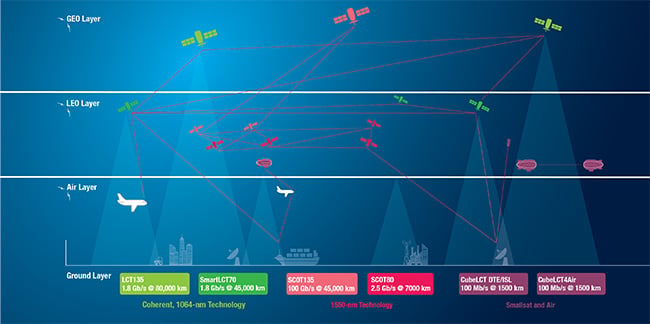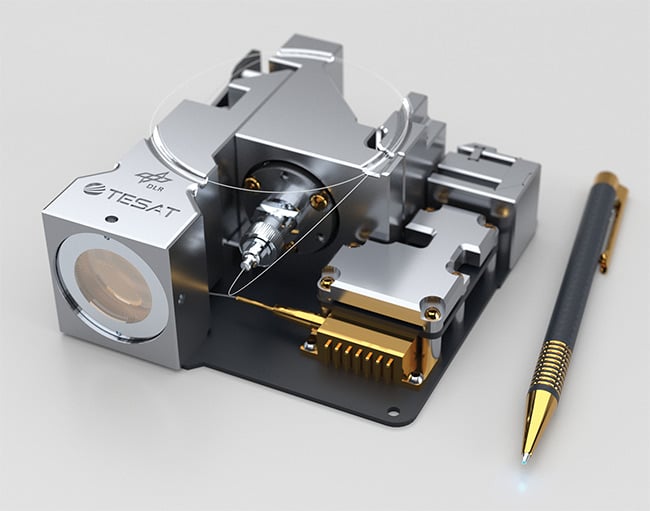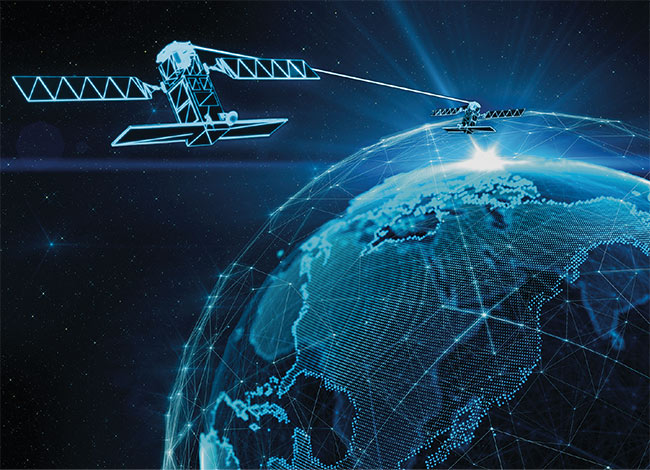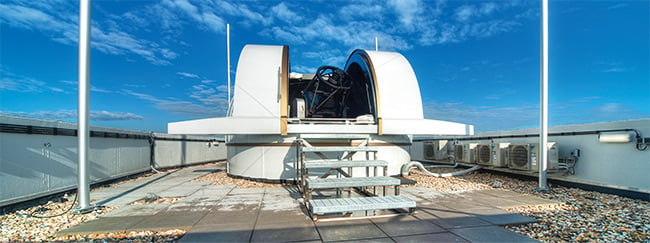Optical free-space networks have a secure future in ground-to-space and space applications. But companies in the market for the long run see considerable untapped potential in the terrestrial market as well.
MARIE FREEBODY, CONTRIBUTING EDITOR
Free-space optics (FSO) and systems are uniquely valuable in enabling fast and secure connectivity, both in terrestrial and nonterrestrial networks. With major advancements in space optics over the last 20 years, ultrahigh-bandwidth signals now regularly ping back and forth over great distances, providing a communications canopy that extends over the entire globe.

A typical free-space communications concept applied in a low-Earth-orbit satellite constellation. Each satellite carries four optical communications terminals that link to neighboring satellites in each direction to form a mesh network. Courtesy of TESAT.
From transmitters to receivers and all the associated optics in between, each technological jump in the past two decades has helped make free-space communications cheaper, faster, easier to deploy and, ultimately, more commercially viable. Research firm Global Market Estimates forecasts that the value of the FSO (aka optical wireless) sector will grow from $4.4 billion in 2022 to $47.5 billion by 2027, at a compound annual growth rate of 34.1%.
Multiple advanced technologies are at play. These include high-power small-linewidth lasers; complex optomechanical control systems, such as fine-steering mirrors able to shape and steer the laser accurately; highly sensitive detectors; adaptive and coherent optics used to compensate for atmospheric aberrations; high-speed digital processing devices for encoding and decoding signals; and photonic integrated chips (PICs) that help miniaturize optical signal processing components.
Alongside the technical progress, demand for evermore data bandwidth is also driving interest in free-space networks, both above and on the Earth’s surface.
Mega constellations
The push for more bandwidth around the world has prompted several companies to deploy mega constellations that sometimes comprise thousands of satellites, most of which are linked by free-space optical systems and are capable of exchanging optical data signals with earthbound terminals.
Typically, one of these satellites carries four optical communications terminals aimed at four surrounding satellites in the same constellation to create a meshed network arrangement. These networks not only provide speedy data transfer, they also offer built-in redundancy through which signals can easily bypass a malfunctioning satellite. The optical signals transmitted across this mesh network can then communicate via laser with ground-based systems.

Free-space optical networks deliver wireless access solutions that can be deployed quickly — with more bandwidth and security, as well as reduced power consumption — versus traditional point-to-point microwave links. Courtesy of EFFECT Photonics BV.
“In a satellite system, the laser signal from an Earth-based terminal has to lock on to the satellite as it comes over the horizon, then wait until the line of sight has been reduced to an acceptable level before transmitting data at maximum speed,” said John Reid, scientific director and co-founder of Aircision, located in Eindhoven, the Netherlands. “Reducing the line of sight reduces the distortions to the optical signal through atmospheric turbulence.”
The first research group to report laser satellite communications at gigabit speeds was the European Data Relay System (EDRS), a commercial partnership agreement between Airbus and the European Space Agency (ESA). The network is intended, in part, to buttress the Copernicus program, which is jointly managed by the ESA and the European Commission. By some estimates, Copernicus will require spaceborne telecommunications infrastructure to transmit terabytes of Earth observation data every day from space to ground. Supplying ground stations with this data in real-time is useful for time-critical monitoring of land, sea, and ice, as well as for government and security services.
EDRS uses low-Earth-orbit (LEO) links to geostationary intersatellite to distribute large data sets to the ground. Since constellations such as the EDRS transmit data via a fixed geostationary satellite that maintains a constant line of sight with ground stations, the long wait for a suitable link up is no longer necessary.
“This scheme allows [us] to significantly increase the amount of data that can be downloaded,” said Herwig Zech, product manager of laser communications at Backnang, Germany-based optical terminal specialist TESAT. “In addition, a real-time data transmission to ground is possible.”
This stationary orbit is also part of what enables the Copernicus constellation to downlink more than a terabyte of Earth observation data daily.
As demand grows for more low-Earth-orbit constellations, so will demand for more satellites. This, in turn, will lead to further optimization and commercialization of the necessary technology. Today, plans to launch several low-Earth-orbit constellations are underway that will multiply the number of FSO terminals in orbit. Among the organizations and initiatives driving this trend are the Telesat Lightspeed LEO Network (188 satellites), Rivada Space Networks (600 satellites), and Project Kuiper (3236 satellites), to name a few.
With 12,000 satellites, SpaceX’s
Starlink is perhaps the highest-profile mega constellation, as well as the largest low-Earth-orbit satellite constellation.
Its satellites occupy an orbit at about
550 km above sea level — relatively close to the Earth — to reduce latency to around 20 ms and support high-data-rate activities such as gaming and streaming with speeds of 50 to 500 Mbit/s.

A network of optical communications links, showing intersatellite links in low-Earth-orbit (LEO) and geosynchronous equatorial orbit (GEO) layers, as well as free-space links to aircraft, balloons, and ground stations. Courtesy of TESAT.

According to TESAT, its CubeL is the smallest optical communications terminal for cubesats dedicated to free-space communications. Courtesy of TESAT.
Unlike fixed, below-ground telecommunications fibers, these constellations can be maneuvered to locations wherever the need arises. Such needs might include communications during natural — or manmade — disasters, for example.
Early last year, truckloads of plug-in terminals were delivered to the Ukraine to compensate for the damage to its communications links caused by Russian bombardment.
The ground-based dishes also provided a crucial lifeline to Ukraine’s military forces, through which users could connect to the nearest Starlink satellite to then communicate with the nearest ground
station located in neighboring Poland.
High-performance but affordable
optical systems designed to withstand rigorous mechanical, thermal, and radiation conditions will be critical to the success of such mega constellations, Zech said. “These systems will include space-qualified optical amplifiers with sufficient optical output power, electronics with high data-rate capability and space-proven pointing, acquisition, and tracking algorithms to establish links between satellites at long distances.”
Ewa Kadziolka — business developer of satellite communications at TNO, the Dutch organization for applied scientific research — said she believes that in the coming years more standardization will be needed to further adapt and implement FSO. “Providers will look for small terminals that are quick and scalable, with a high degree of intercompatibility, while users will require fast connectivity with high availability,” she said.
Data demand drives FSO
While satellites increasingly link to each other using the optical regime, today’s ground-to-satellite communications are transmitted via traditional radio frequency (RF) or microwave links. The trouble is that this space is rapidly becoming crowded. Unlike the optical spectrum, licenses are required to reserve RF and microwave transmission bands, which has prompted growing interest in employing FSO in satellite-to-ground communications. In addition to circumventing the competition for licenses, this could also drive data rates into the 100-Gbit/s range and above.
“The biggest barrier to implementation is investment in space qualification,” said Andy Vick, head of disruptive technology at RAL Space, the space hub for UK Research and Innovation, and part of the Science and Technology Facilities Council. “Probably the best thing that suppliers can focus on is hermetic packaging, as that helps with most of the environmental challenges and will speed space qualification of technologies.”


Above the interference from the Earth’s atmosphere, optical intersatellite links send signals back and forth over the entire globe (top).
TNO Optical Ground Station in Den Haag, the Netherlands (bottom). In conjunction with Airbus Defence and Space Netherlands, TNO recently demonstrated a ground-level
laser communication link over 10 km in the Netherlands — the first such optical data connection to operate in real-world conditions using conventional infrastructure, the company said. Courtesy of TESAT.
Terrestrial fiber optic networks regularly achieve data rates of 100 Gbit/s and more, TESAT’s Zech said. Leveraging this technology in spaceborne wireless optical networks, however, requires their qualification for a very different operating environment. “The goal is to identify potential elements or parts in the 100-Gbit/s modules that may potentially suffer under the harsh conditions in space, and to find measures to cope with this situation,” he said.
This work is already underway at TESAT, which put its 100-Gbit/s biodirectional ConLCT80 wireless optical modem through the paces to ensure reliable coding and framing according to the U.S. Space Development Agency’s (SDA’s) standards.
The company further tested data rate, wavelength compatibility, tracking tone, waveform capture, and continuous data transfer for the terminal, as it will operate in space aboard SDA’s Tranche 0 Transport Layer constellation currently due to be launched in March.
Another high-data-rate, space-qualified laser terminal is part of TNO’s TOmCAT (Terabit Optical Communication Adaptive Terminal) project, which began two years ago as an agreement between TNO and Airbus Defence and Space Netherlands to commercialize a TOmCAT terminal. In September 2022, the consortium demonstrated a ground-level laser communication link over 10 km in the Netherlands, claiming it was the first such optical data connection to operate in real-world conditions using conventional infrastructure. The exercise, however, also offered a proof of concept for ground-to-space platforms.
“This is an example of a ground-to-space optical link that feeds data throughputs of 1 Tbits/s and beyond,” Kadziolka said. “Airborne optical terminals can even link aircrafts into satellite networks, providing connectivity for people in the air.”
Securing transmissions
FSO lends itself well to secure quantum-based optical techniques in which single-photon sources and detectors are used to encrypt data and transfer it securely over long distances. In effect, FSO links do not pose the same transmission losses and limited distance that quantum key distribution (QKD) techniques exhibit on fiber networks. And FSO can further leverage conventional wavelength division multiplexing techniques to send encrypted data at higher rates.
“The enterprise market [for QKD] is an interesting arena, and our company has been approached by various enterprises looking to deploy a private secure on-site network,” Reid said. “Currently, QKD is limited by the lack of a suitable optical amplifier to overcome the limitations of fiber transmission, but FSO may offer a solution.”
The enterprises courting Aircision are in high-tech and finance, he said. But the defense sector could also benefit from communications channels that cannot be detected, tapped, or hacked by conventional methods.
Quantum encryption over FSO has evolved enough that some NATO navies are testing the technology for ship-to-
ship communications, Reid said, but
challenges remain. “This application includes all the issues of maintaining a communications link and combating atmospheric conditions while transmitter and receiver are both moving in a random manner.”
Terrestrial transceivers
The same atmospheric constraints that apply to ground-to-space networks also hamper terrestrial FSO communications. But as the cost of key optical components comes down, terrestrial FSO systems are seeing more opportunities to supplant fiber-based networks.
“Free-space microwave and RF technology is not able to keep up with the speed and reach of FSO systems,” said Joost Verberk, director of product management at EFFECT Photonics BV. “For anything beyond 10G, microwave technology will no longer work. Also, wired fiber deployments don’t make sense in terms of return on investment for remote communities with lots of kilometers of fiber distance but only a few customers.”
Transceiver technology for coherent
optical transmission has advanced significantly in recent years. Originally developed for optical fiber transmission, a 100-Gbit/s coherent transceiver is now relatively inexpensive and readily available. Higher-speed transceivers are also on the horizon to deliver higher bitrates of 400 and 800 Gbit/s.
“This plays into future FSO systems whereby we can leverage this work to provide operators with a system scalable in bandwidth,” Aircision’s Reid said. “This is an important consideration for an operator when buying into a technology solution: It must be future-proof in that it should provide a path for future upgrades when required.”
The insatiable call for faster, high-capacity communications and data rates guarantees a strong outlook for FSO.
There is no point in a future-proof
technology, however, if it cannot provide a return on investment in the near term. Yet, as a number of FSO systems are planned, due to the perceived high
reliability of the technology, this is helping to drive investment in further advancements.
“Second-tier, or lower, operators are inclined to be faster adopters of new
technology if it can generate market share for a lower total cost of ownership,”
Reid said. “Here, FSO can play a role, compared with alternative technologies.”
For example, a collaboration between Aircision and EFFECT Photonics aims to push the boundaries of ground-to-ground FSO technology by combining the advantages of integrated and free-space photonics. In late 2021, Aircision successfully demonstrated its first 10 Gbit/s FSO system, at which point EFFECT Photonics joined forces to help encapsulate the technology in a more compact and low-power pluggable optical transceiver that could become a model for more efficient and effective FSO systems in the future.
In addition to allowing higher-bandwidth free-space transmission, the pluggable transceiver can also transmit over 5 km, which means fewer devices are needed and less power is consumed. The system can also be deployed in under six hours, meaning upgrades are fast.
The future of FSO
The insatiable call for faster, high-capacity communications and data rates guarantees a strong outlook for FSO. Although the Earth is better connected than ever before, the future is trending toward an increasingly pervasive Internet of Things that connects and communicates data to and from billions of devices — from cars and shipping containers to lighting and surveillance cameras, for example. FSO’s ability to extend data exchanges beyond cabled infrastructure will ensure that the technology plays a critical role.
Optical wireless communications technologies have already made great strides, particularly above the atmosphere, but also at ground level, where secure, high-bandwidth information transfer still has a way to go.
In the future, 6G mobile systems will be rolled out, and standardization committees are working on specifications. But one thing is already clear: The proposed 6G requirements will require more bandwidth.
“This will be a challenge that all currently used technologies will have to address,” Reid said. “FSO can play an important role here, offering operators an extra technology capable of the kinds of bandwidth that are going to be required in the backhaul network.”
Acknowledgment
John Reid of Aircision, who kindly contributed his expertise to this article, passed away in November. The author and Photonics Media wish to express their appreciation for Reid’s insights, as well as their sadness over the loss of an excellent industry source.